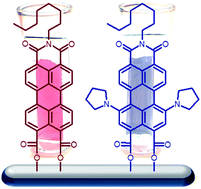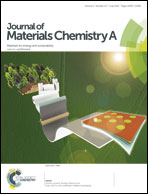Synthesis and study of electrochemical and optical properties of substituted perylenemonoimides in solutions and on solid surfaces†
Abstract
A new and efficient methodology towards the synthesis of 7-pyrrolidinyl and 7,12-bispyrrolidinyl perylenemonoimide monoanhydrides (PMI monoanhydrides) and their corresponding dicarboxylic acids is devised. The high yields (70–96%) and facile synthesis of PMI monoanhydrides, as compared to traditional methodologies, make the method attractive and versatile. The reported 7,12-bispyrrolidinyl PMI monoanhydrides are a new family of peryleneimides, where both the bay-substituents are located towards the anhydride cycle. The electrochemical and optical properties of target molecules and their precursors were investigated using UV-Vis spectroscopy and differential pulse voltammetry. Atomic charges and electronic properties were calculated using density functional theory (DFT). In addition, self-assembling monolayers of the PMI monoanhydrides and their corresponding diacids were successfully formed over ZnO and TiO2 films. The results of the current study indicate that these molecules are potentially good candidates for various applications in the fields of organic electronics and solar cells.

- This article is part of the themed collection: Artificial Photosynthesis

 Please wait while we load your content...
Please wait while we load your content...